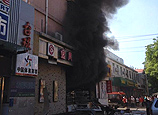
 |
| The country's IT spending grew 19.8 percent year-on-year to 1.38 trillion yuan ($225 billion) from January to May. The government plans to boost IT spending by more than 20 percent annually through 2015. ZHANG CHENG / XINHUA |
New sectors will open up despite weak demand and overcapacity
Although several indicators point to an overall weakening in the industrial sector, officials at the Ministry of Industry and Information Technology still see major opportunities for the information technology sector in the second half of the year.
Efforts to boost demand in the IT sector will provide "fresh momentum" for China's industrial growth in the second half of the year, Zhu Hongren, chief engineer and spokesman for the ministry, said at a Wednesday news conference.
His comments echoed those in a meeting held on July 12 by the State Council, in which Premier Li Ke-qiang called for upgrading the nation's economic structure by boosting demand in the IT industry.
Zhu Jun, an official at the ministry, said during Wednesday's conference that specific measures to boost demand in the IT sector include launching the "broadband China" program and accelerating the construction and upgrading of infrastructure in the telecommunications and Internet sectors.
Also, to boost demand, the nation will establish public information service platforms and develop more IT products and content.
The State Council meeting also promised to issue operating licenses for the fourth-generation mobile Internet this year.
China has also issued standards for optical fiber home access and ordered that all new housing at county-level and above must have access to optical fibers.
China aims to boost public and household spending on the IT industry by more than 20 percent annually through 2015, according to the State Council meeting.
From January to May, IT spending grew 19.8 percent year-on-year to 1.38 trillion yuan ($225 billion). E-commerce turnover rose 46 percent to 4 trillion yuan, according to the ministry figures.
As growth in China's traditional industrial sectors slows, the nation is seeking new growth engines in emerging industrial sectors. Zhu Hongren said the goal is to make the IT sector the nation's third-largest, after real estate and vehicles.
Industrial output grew 8.9 percent year-on-year in June, dragging the first-half figure to 9.3 percent, well below the 10 percent annual growth target set by the ministry.
Another important indicator, the Producer Price Index, which measures inflation at the wholesale level, contracted for the 16th consecutive month.
The slowdown showed no sign of improving in July. The preliminary reading of the Purchasing Managers' Index released by HSBC Holdings Plc on Wednesday was 47.7, the lowest in 11 months. Readings below 50 indicate contraction.
But Zhu contended that there are also signs pointing to an improvement of the industrial structure.
High-technology industries' added value in the first half grew 11.6 percent, 2.3 percentage points above the average for all industries.
From January to May, the gross profit of large enterprises expanded 12.3 percent year-on-year, compared with a 2.4 percent drop a year earlier.
Still, the country's industrial economy is plagued by weak demand, overcapacity and growing problems for small and micro enterprises, Zhu admitted.
In addition to IT, officials said there are another two "silver linings" for the economy: demand to combat air pollution and new measures to invigorate the corporate sector.
New measures in these two fields will be rolled out soon, Zhu said.
Wang Xiaokang, president of the State-owned China Energy Conservation and Environmental Protection Group, said there is "tremendous potential demand" in the environment-related area.
Priority sectors include soil and underground water remediation, sewage pumping networks, air pollution controls, heavy metal decontamination and energy efficiency, Wang said.
















 Dog survives after 30 hours buried in debris
Dog survives after 30 hours buried in debris


![]()
